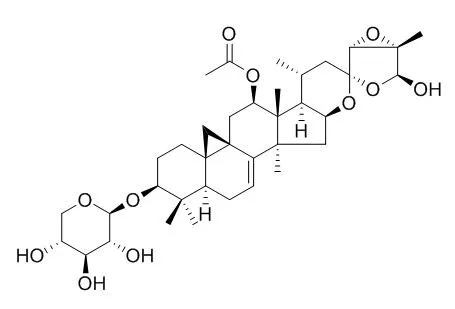| Eur J Pharm Sci. 2009 Nov 5;38(4):355-61. |
| Inhibition of nucleoside transport and synergistic potentiation of methotrexate cytotoxicity by cimicifugoside, a triterpenoid from Cimicifuga simplex.[Pubmed: 19748575] |
Cimicifugoside, a triterpenoid isolated from Cimicifuga simplex, which has been used as a traditional Chinese medicine due to its anti-inflammatory, analgesic or anti-pyretic action, was examined for inhibition of nucleoside transport and synergistic potentiation of methotrexate cytotoxicity.
METHODS AND RESULTS:
Cimicifugoside inhibited uptake of uridine, thymidine and adenosine in human leukemia U937 cells with the low nanomolar IC(50) values, but did not affect that of uracil, leucine or 2-deoxyglucose at Cimicifugoside analogs differentially inhibited uridine uptake in the order Cimicifugoside>cimicifugenin (aglycon of Cimicifugoside)>bugbanoside B>cimicifugenin A, O-methyl cimicifugenin and bugbanoside A. Cimicifugoside had less affinity for the binding site of nitrobenzylthioinosine (typical high-affinity inhibitor of equilibrative nucleoside transporter-1) in U937 cells, K562 cells and human erythrocyte membranes compared with the prototype nucleoside transport inhibitor dipyridamole. Cimicifugoside markedly potentiated methotrexate cytotoxicity in a culture of U937 cells and human carcinoma KB cells. Potentiation of methotrexate cytotoxicity by Cimicifugoside analogs in U937 cells was in proportion to their inhibitory activity against uridine uptake.
CONCLUSIONS:
The present study demonstrates that Cimicifugoside is a novel specific nucleoside transport inhibitor that displays synergistic potentiation of methotrexate cytotoxicity. |
| Res Commun Chem Pathol Pharmacol. 1981 Jun;32(3):565-8. |
| Differential cytotoxicity of cytosine arabinoside toward murine leukemia L1210 cells and murine bone marrow progenitor cells inhibited in nucleoside transport by cimicifugoside.[Pubmed: 6791252] |
METHODS AND RESULTS:
Cytotoxicities of cytosine arabinoside (Ara C) and showdomycin to murine L1210 leukemia cells was prevented by a nucleoside transport inhibitor, Cimicifugoside. Ara C toxicity to bone marrow progenitor cells, however, was observed even in the presence of Cimicifugoside.
CONCLUSIONS:
The difference of Ara C toxicity toward L1210 cells and bone marrow cells pretreated with Cimicifugoside may be originated in the different characteristics of membrane transport site of nucleosides. |
| J Pharmacobiodyn. 1980 Dec;3(12):643-8. |
| The immune response of splenic lymphocytes after cimicifugoside treatment in vitro and pretreatment in vivo.[Pubmed: 7277179] |
METHODS AND RESULTS:
Pretreatment of mouse splenocytes with Shigella lipopolysaccharide and concanavalin A followed by 50 ng/ml of Cimicifugoside resulted in a 69% and 31% inhibition of blastogenesis compared to controls. The plaque forming colony assay using sheep erythrocytes (SRBC) showed a decreased number of plaque forming colonies after exposure of the splenic cells to 1 microgram/ml of Cimicifugoside. Cimicifugoside, 0.1 mg/mouse i.p. suppressed the anti-SRBC response in the plaque forming assay. The major inhibition of the antibody response occurred when Cimicifugoside was administered 1 day before the primary immunization with SRBC. The delayed type hypersensitivity to picryl chloride was suppressed after i.v. administration of Cimicifugoside, 1.0-2.0 mg/mouse.
CONCLUSIONS:
The immunosuppressive activity of Cimicifugoside is preferentially directed toward B-cell function with larger doses being required for suppression of T-cell function. |






 Cell. 2018 Jan 11;172(1-2):249-261.e12. doi: 10.1016/j.cell.2017.12.019.IF=36.216(2019)
Cell. 2018 Jan 11;172(1-2):249-261.e12. doi: 10.1016/j.cell.2017.12.019.IF=36.216(2019) Cell Metab. 2020 Mar 3;31(3):534-548.e5. doi: 10.1016/j.cmet.2020.01.002.IF=22.415(2019)
Cell Metab. 2020 Mar 3;31(3):534-548.e5. doi: 10.1016/j.cmet.2020.01.002.IF=22.415(2019) Mol Cell. 2017 Nov 16;68(4):673-685.e6. doi: 10.1016/j.molcel.2017.10.022.IF=14.548(2019)
Mol Cell. 2017 Nov 16;68(4):673-685.e6. doi: 10.1016/j.molcel.2017.10.022.IF=14.548(2019)